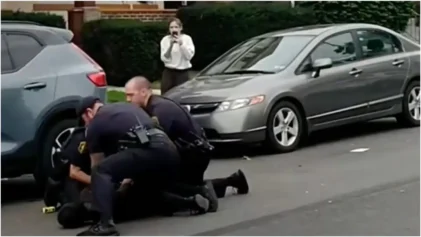The fate of a historical marker remembering a Black man lynched in Mobile, Alabama, hangs in the balance as a controversy about whether it should go up at all causes an uproar.
Mobile is in the midst of recognizing its racist past, and its latest project, installing a historical marker memorializing Richard Robertson, a Black man lynched in 1909, has become as much of a controversial issue as the lynching itself.
“There were six lynchings that occurred in Mobile County during the era of racial terror, now we know there were many many more,” Mobile County Community Remembrance Project member Karlos Finley said, referencing numerous undocumented lynchings that occurred during the early 1900s.
The Mobile County Community Remembrance Project is spearheading the installation of historic marker about Robertson. On Jan. 23, 1909, Robertson, who was working as a carpenter, was accused of an assault by two white plumbers. When deputies arrived to arrest Robertson, he fled, leading to a shootout.
“Mr. Robertson was alleged to have shot, killed and injured deputies with the Mobile County Sheriff’s Department, which he was apprehended because he himself was shot,” Finley said.
Robertson was taken to jail, but like in many lynchings at the time, an angry white mob decided to take the law into its own hands.
“He was taken from the jail by a white lynch mob, taken about a block and a half away from the jail, lynched using the hanging method as well as the shooting method,” Finley said.
It is still unclear if Robertson actually killed the deputy, as he did not live to see a trial, but the larger point was made to strike fear in the hearts of African-Americans. “Lynching was not only crime against the individual, but it was also used as an intimidation factor,” Finley said.
Fast-forward 113 years, and the Equal Justice Initiative, a nonprofit committed to ending mass incarceration and excessive punishment in the U.S., is working with communities across the country to memorialize documented victims of racial violence. Robertson was next on their list to be formally recognized in Mobile, which has a population of about 413,000 people, with 36 percent Black, according to Census data.
Finley says the Remembrance Project initially planned to place the historical marker of Robertson’s lynching in downtown Mobile in a spot formerly occupied by a Confederate statue of Raphael Semmes.
“The Mayor decided it was a controversial location because the statue of Admiral Semmes used to be there and it was removed, so we went back into negotiations and we negotiated a different spot,” Finley said.
Semmes was a Civil War admiral, and his statue once stood in downtown Mobile as a symbol of the Confederacy. During the racial reckoning in the summer of 2020, when many Confederate statues were taken down, Semmes was also removed and placed into a local museum, according to WPMI.
The Remembrance Project went back to the city to negotiate a new location to host the historical marker of Robertson, and it settled on the courthouse downtown because it was the site of the old courthouse which is also near where Robertson was lynched. The organization says it initially had the support of Mobile Mayor Sandy Stimpson for the new location.
“The lynching of Richard Robertson, who had been dragged from the jail, which in effect was in the courthouse, we wanted to place this marker in front of the Mobile County Courthouse. We went through the process again, we were approved and two days before the unveiling, the other two County Commissioners decided they would not support it,” Finley said.
With the objection of two of the three Mobile County commissioners to place the marker at the courthouse, a controversy erupted and unearthed racial tensions. The opposing commissioners are Randall Dueitt and Connie Hudson, both of whom are white. The commissioners sent letters to the Mayor Stimpson explaining their opposition.
Hudson’s opposition hinges on the marker’s location, saying in her letter, “The main entrance to Government Plaza is a very busy pedestrian ingress and egress and presents an inappropriate location for any type of vertical structure on the pathway into the building.” Hudson then requested the city withdraw the permit for the marker.
In Commissioner Dueitt’s opposition letter, he says, “Numerous and documented reports that Mr. Robertson had shot and killed a Mobile County Deputy Sheriff and injury another Deputy Sheriff. It is my strong belief that regardless of circumstances surrounding the death of Mr. Robertson, no one should be honored for taking the life of a law enforcement officer.” He continued by saying, “I do not condone the circumstances surrounding the death of Robertson, but with my past employment as a sworn law enforcement officer, I cannot support the placement of this maker of Robertson at any location.”
“I don’t feel any one of those reasons should disrupt the significance of the marker,” said Robert Clopton, president of the Mobile chapter of the NAACP.
Clopton does not buy the opposing commissioners’ excuses for not supporting the marker’s placement at the site of the old courthouse. He believes the marker should go up as planned because too often history is whitewashed, especially African-American history.
“From our position we just want the truth to be told, that’s what we want, the truth to be told, we’ve seen so many times where critical race history has tried to eliminate history,” said Clopton.
Both Dueitt and Hudson said the lone Black commissioner on the board, Merceria Ludgood, who is also a member of the Equal Justice Initiative, told them about the planned marker several months ago, at which time they also opposed.
Atlanta Black Star sought comment from Ludgood, but she declined our interview request.
Mobile Mayor Sandy Stimpson sent Atlanta Black Star a statement on the matter.
“I am fully supportive of the efforts to recognize the victims of extrajudicial killings that occurred during some of the darkest periods of our community’s history. There has recently been discussion about an appropriate location to display a marker recognizing the lynching of Richard Robertson in 1909, but in the meantime, I did not want the City of Mobile to be an impediment to displaying the marker. Two weeks ago, City employees installed the marker along Church Street in the closest and most feasible location to where the lynching occurred 113 years ago. For the time being, the marker will be well maintained at this historic site near Mardi Gras Park. However, I remain open to relocating the marker to another agreeable location in the future if that is the desire of EJI and the Mobile County Remembrance Project.”
Until a permanent home for the marker is established, a spokesman for the city of Mobile confirmed, the marker currently sits “in the closest publicly-accessible area to where Mr. Robertson was killed in 1909. It’s near the corner of Church Street and Royal Street and the entrance to Mardi Gras Park.”
Clopton also wants this controversy to be resolved so future generations in the Mobile community can learn from past wrongdoings.
“I think at some point in time in generations to come, preferably someone will look up and realized there was a mistake made, a man lost his life, he lost it to a mob that again were law, judge, jury and executioner and we can’t tolerate things of this nature in the future,” Clopton said.


